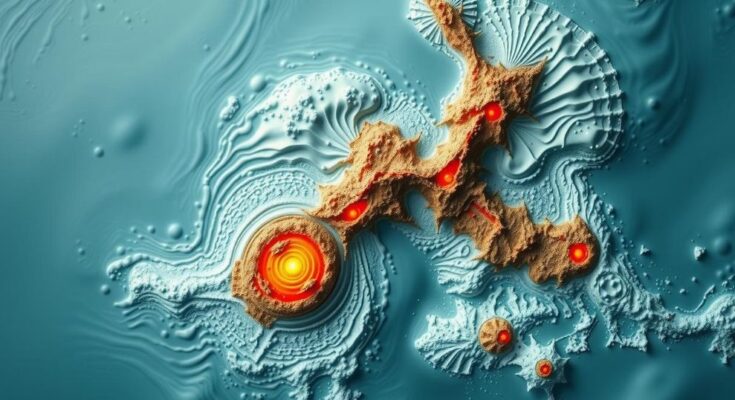A slow-slip earthquake is currently taking place near Hawke’s Bay, involving significant land displacements recorded by GNSS stations. This event highlights the ongoing dynamics within the Hikurangi Subduction Zone, which has been the focus of international research to study slow-slip events and their relationship with regular seismic activity. Instruments deployed in this region aim to refine our understanding of these geological phenomena.
A slow-slip earthquake (SSE) event is currently underway near Hawke’s Bay, New Zealand, specifically along the Hikurangi Subduction Zone. This tectonic region marks the boundary between the Australian and Pacific plates, facilitating a myriad of geological activities. Recent data from Global Navigation Satellite System (GNSS) stations has indicated land displacements of approximately 4 cm eastward and 1 cm southward over a span of three weeks in December. Notably, areas between Wairoa and Tolaga Bay reported displacements of up to 8 cm, suggesting significant tectonic movement occurring within a condensed timeframe.
The Hikurangi Subduction Zone has a history of SSE events, with the most recent noted in June 2023, highlighting a pattern of recurrence in this geological area. Ongoing research has intensified since 2014, with the deployment of over 50 offshore instruments to monitor tectonic movements. This international effort, involving scientists from New Zealand, Germany, Japan, and the United States, seeks to map the extent of SSEs and improve the understanding of subduction dynamics.
In 2023, two observatories were installed beneath the seafloor near the SSE location to collect comprehensive data on these slow-slip events. In addition, a U.S.-funded initiative has provided seafloor flowmeters aimed at examining sub-seafloor water movement associated with SSEs. In early 2024, data collection efforts utilizing an underwater remotely operated vehicle were initiated, contributing valuable insights into the mechanics of SSEs and their link to standard seismic activity.
The Hikurangi Subduction Zone, the largest fault in New Zealand, is characterized by a persistent movement of the Pacific Plate between 2 to 6 cm per year. Though SSEs occur gradually over weeks to months without visible ground shaking, they play a critical role in stress management within the subduction zone, potentially triggering smaller earthquakes in adjacent areas. Numerous minor earthquakes with magnitudes between 2 and 4 have been detected near the Mahia Peninsula, correlating with the current SSE activity. Importantly, while SSEs are not exclusive to New Zealand, they represent a significant element of the country’s tectonic framework, facilitating the gradual redistribution of stress.
The Hikurangi Subduction Zone is a crucial tectonic boundary that delineates the interaction between the Australian and Pacific plates along the eastern coastline of New Zealand’s North Island. This zone is renowned for its geological complexity and activity, with slow-slip earthquakes being a peculiar phenomenon observed since the early 2000s. Given the geological significance of slow-slip events, they have become an area of intense international research, aiming to uncover the underlying processes behind these phenomena and their implications for seismic activity in the region.
In summary, the ongoing slow-slip earthquake event near Hawke’s Bay exemplifies the intricate geological activities occurring within the Hikurangi Subduction Zone. The collaboration among international researchers aims to enhance the understanding of tectonic movements and the relationship between SSEs and regular seismic activity. The advancements in monitoring technologies offer exciting prospects for more profound insights into the dynamics of the subduction zone, further informing our understanding of earthquake-related risks in New Zealand.
Original Source: watchers.news




